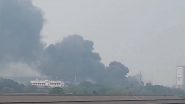By Lee Kah Whye
Singapore, July 13 (ANI): The fascinating story of AirAsia's rise to become one of the most admired carriers in the region is well known in Southeast Asia.
It began with the purchase of the bankrupt airline from Malaysian government conglomerate DRB- Hicom back in December 2001 by legendary and flamboyant founder, Tony Fernandes. It was a gutsy move so soon after the September 11 tragedy in America which devasted the airline industry. Although he ostensibly paid 1 Malaysian Ringgit (now 23 US cents) for the airline, he had to take on USD 11 million of debt and in order to finance the operations, he had to mortgage his house and plough his entire savings into the venture since no banks would lend him money as he had no prior experience running an airline. Before taking this big spin of the roulette wheel, he had a cushy high-flying job as a Warner Music executive which he joined as an accountant.
He and business partner and old friend, co-founder Kamarudin Meranun, took over two ageing Boeing 737-330 planes and 200 staff after the acquisition and were profitable within one year, flying 200,000 passengers in 2002. Five years later in 2007, they had 68 planes, another 175 on order, and had 5,000 people working for the airline. They flew 23 million passengers that year. That is more passengers than SIA (Singapore Airlines), MAS (Malaysian Airlines), Thai Airways, Emirates or Cathay.
By 2017, it was operating with 220 aircraft, employed 20,000 people, and was carrying 65 million passengers annually. As of 2019, AirAsia had the enviable achievement of winning Skytrax's world's best low-cost carrier for 11 consecutive years in their international travel and airline awards.
AirAsia took on a low-cost carrier business model with a slogan that resonated with regional travellers: "Now everyone can fly". It inspired the birth of many Southeast Asian low-cost airlines like SIA's Tiger Airways (now merged with Scoot), Jetstar Asia, Indonesia's Lion Air and Air Mandala, Philippines' Cebu Pacific and Thailand's Nok Air.
Starting in 2004 with Thai AirAsia, the airline started its regional expansion by establishing joint-ventures or other forms of partnerships in various countries including Indonesia, Philippines, Japan and India. Their affiliate in China was closed not long after starting for commercial reasons.
Its airline in India is a joint venture which started in 2013. It owns 49 percent of the venture, with Tata Sons and Arun Bhatia the other shareholders. This partnership saw aviation pioneer Tata Sons' first return to the aviation industry after an absence of 60 years.
Following AsiaAsia's listing in 2004, Tony Fernandes, who is an overseas citizen of India, was listed by Forbes as Malaysia's 28th richest man with a net worth of USD 650 million in 2014. He once owned a Formula One team and is currently co-owner of London football club Queens Park Rangers.
AirAsia is run frugally and with a reported cost of USD 0.0375 per available seat per kilometre (ASK) in 2019 is operating one of the world's lowest cost per ASK for any carrier. In spite of this, it could not escape the carnage the COVID-19 pandemic was wreaking on the airline industry as borders closed and flights were suspended.
With little revenue for months, the airline last week unsurprisingly reported a record loss of MYR 803 million (USD 188 million) for the first three months of the year. Before COVID-19, it was already hampered by a net loss of MYR 304 million (USD 71 million) in 2019. At the end of Q1 2020, the airline's current liabilities exceeded its current assets by MYR 3.565 billion (USD 840 million).
Auditors Ernst & Young said in an unqualified audit opinion statement to the Kuala Lumpur Stock Exchange that "travel and border restrictions implemented by countries around the world has led to a significant fall in demand for air travel which impacted the group's financial performance and cash flows." It noted the "existence of material uncertainties that may cast significant doubt on the group's and the company's ability to continue as a going concern."
Trading of shares in AirAsia was suspended last Wednesday (8 July) morning and had plummeted 23 percent by the end of the day after trading resumed in the afternoon. It has since recovered 10 percent as of at the end of the week.
Earlier, AirAsia had already taken steps to minimise costs, including cutting about 7.5 percent of its 23,000 employees across its businesses. It is also negotiating with suppliers for payment deferrals and has halted aircraft deliveries.
AirAsia is at the moment exploring various means to inject cash into its ailing business. Analysts say that a combination of funding options would probably be required especially since banks are unlikely to lend without shareholders supporting a capital-raising exercise. Some think that they can at best raise MYR 1.4 billion from a rights issue while Malaysian equities research firm CGS-CIMB believes they will need MYR 3 billion (USD 700 million) in new funding to maintain a healthy cash position.
One potential investor is South Korea's conglomerate SK Corp who are ready to make a small private placement. However, this is likely to be subject to the securing of government and bank loans of about MYR 1 billion. Financial institutions have already indicated that they are willing to provide conditional loans.
Their subsidiaries in Indonesia and the Philippines have also applied for loans.
One other possible source of funding is a sale of their stake in AirAsia India to Tata Sons and discussions have already been set in motion based on a report by Business Standard.
AirAsia boss Fernandes remains optimistic that his firm can survive what he said is the toughest challenge they have faced since they began in 2001. He said in an interview with news agency AFP on Thursday (July 9) that the budget carrier would emerge "stronger" from the coronavirus pandemic, and said the airline was hopeful of raising a sizeable cash injection.
He added, "every crisis is an obstacle to overcome, and we have to restructure the group into a leaner tighter ship." And, that since operations resume in late April, there has been a strong rebound in demand. "We are flying domestically, we know that international flights are not far away," he said. "AirAsia is in a good market because COVID has been pretty well controlled in (Southeast Asia) and North Asia." (ANI)
(This is an unedited and auto-generated story from Syndicated News feed, LatestLY Staff may not have modified or edited the content body)














 Quickly
Quickly















